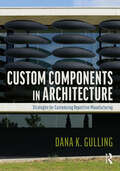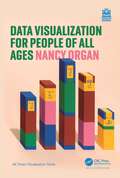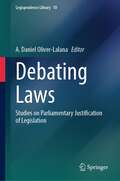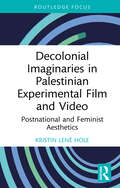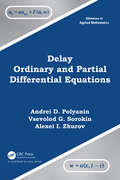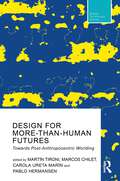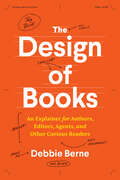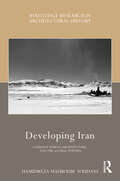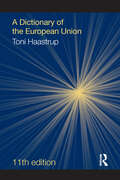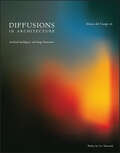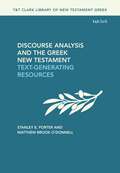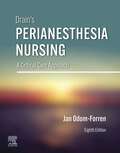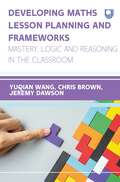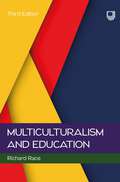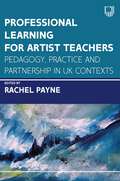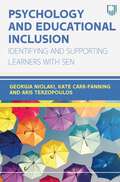- Table View
- List View
Custom Components in Architecture: Strategies for Customizing Repetitive Manufacturing
by Dana GullingThis book offers architects strategies in the design and manufacturing of custom, repetitively manufactured building components.A total of 36 case studies from around the globe demonstrate the diversity of CRM in architecture and are contributed by architecture firms, including Diller Scofidio + Renfro, Kengo Kuma & Associates, Abin Design Studio, Behnisch Architekten, Belzberg Architects, and many more. The book is organized by manufacturing process and covers the use of various types of glass, clay, plastic, metal, wood, plaster, and concrete. Each process is described with diagrams and text and expanded with one or more examples of customized building components. Projects included are of buildings of various types, sizes, and clients, and many deviate from the typical manufacturing process as they include a secondary process (e.g. casting glass, then slumping it), special tooling modifications (e.g. dams used to subdivide a mold), post-production processes, or other notable manufacturing features. Each case study includes a project overview, behind‐the‐scenes images of the component manufacturing, and original diagrams that illustrate how those components were customized.Custom Components in Architecture will be essential reading for any architect interested in building design details and keeping up-to-speed on material advances. Upper-level students of digital architecture, fabrication, and building technology will also find this a useful tool.
Custom Components in Architecture: Strategies for Customizing Repetitive Manufacturing
by Dana GullingThis book offers architects strategies in the design and manufacturing of custom, repetitively manufactured building components.A total of 36 case studies from around the globe demonstrate the diversity of CRM in architecture and are contributed by architecture firms, including Diller Scofidio + Renfro, Kengo Kuma & Associates, Abin Design Studio, Behnisch Architekten, Belzberg Architects, and many more. The book is organized by manufacturing process and covers the use of various types of glass, clay, plastic, metal, wood, plaster, and concrete. Each process is described with diagrams and text and expanded with one or more examples of customized building components. Projects included are of buildings of various types, sizes, and clients, and many deviate from the typical manufacturing process as they include a secondary process (e.g. casting glass, then slumping it), special tooling modifications (e.g. dams used to subdivide a mold), post-production processes, or other notable manufacturing features. Each case study includes a project overview, behind‐the‐scenes images of the component manufacturing, and original diagrams that illustrate how those components were customized.Custom Components in Architecture will be essential reading for any architect interested in building design details and keeping up-to-speed on material advances. Upper-level students of digital architecture, fabrication, and building technology will also find this a useful tool.
Data Visualization for People of All Ages (ISSN)
by Nancy OrganData visualization is the art and science of making information visible. On paper and in our imaginations, it’s a language of shapes and colors that holds our best ideas and most important questions. As we find ourselves swimming in data of all kinds, visualization can help us to understand, express, and explore the richness of the world around us. No matter your age or background, this book opens the door to new ways of thinking and sharing through the power of data visualization.Data Visualization for People of All Ages is a field guide to visual literacy, born from the author’s personal experience working with world-class scholars, engineers, and scientists. By walking through the different ways of showing data—including color, angle, position, and length—you’ll learn how charts and graphs truly work so that no visualization is ever a mystery or out of reach. It doesn’t stop at what fits on a page, either. You’ll journey into cutting-edge topics like data sonification and data physicalization, using sound and touch to share data across the different senses. Packed with practical examples and exercises to help you connect the dots, this book will teach you how to create and understand data visualizations on your own—all without writing a single line of code or getting tangled up in software.Written with accessibility in mind, this book invites everyone to the table to share the joy of one of today’s most necessary skills. Perfect for home or classroom use, this friendly companion gives people of all ages everything they need to start visualizing with confidence.
Data Visualization for People of All Ages (ISSN)
by Nancy OrganData visualization is the art and science of making information visible. On paper and in our imaginations, it’s a language of shapes and colors that holds our best ideas and most important questions. As we find ourselves swimming in data of all kinds, visualization can help us to understand, express, and explore the richness of the world around us. No matter your age or background, this book opens the door to new ways of thinking and sharing through the power of data visualization.Data Visualization for People of All Ages is a field guide to visual literacy, born from the author’s personal experience working with world-class scholars, engineers, and scientists. By walking through the different ways of showing data—including color, angle, position, and length—you’ll learn how charts and graphs truly work so that no visualization is ever a mystery or out of reach. It doesn’t stop at what fits on a page, either. You’ll journey into cutting-edge topics like data sonification and data physicalization, using sound and touch to share data across the different senses. Packed with practical examples and exercises to help you connect the dots, this book will teach you how to create and understand data visualizations on your own—all without writing a single line of code or getting tangled up in software.Written with accessibility in mind, this book invites everyone to the table to share the joy of one of today’s most necessary skills. Perfect for home or classroom use, this friendly companion gives people of all ages everything they need to start visualizing with confidence.
Debating Laws: Studies on Parliamentary Justification of Legislation (Legisprudence Library #10)
by A. Daniel Oliver-LalanaThis book seeks to explore the potential and actual value of parliamentary debates as a source of legislative justification. Drawing on a sample of recent Spanish legislation, the papers collected here analyse (critically) the rationale of several laws or legislative measures as it can be reconstructed from the respective parliamentary discussions. All issues covered have given rise to intense political, legal and social controversy: they range from the combat against gender violence, the legal status of bullfighting, the protection of crime victims and the so-called ‘push-backs’ at the border, to the regulation of euthanasia, the minimum living income, underage girls’ access to abortion, and joint child custody. The volume is organised into two main parts. The first group of case studies adopt a legisprudential perspective and examine parliamentary deliberations in the light of the theory and methodology of legislative justification; the contributions in the second part follow approaches that fall outside – but are largely compatible with –legisprudence, and deal with aspects such as the rhetorical strategies employed by MPs when debating bills, and the role of elected legislators as constitutional interpreters.
Decolonial Imaginaries in Palestinian Experimental Film and Video: Postnational and Feminist Aesthetics (Routledge Focus on Film Studies)
by Kristin Lené HoleDecolonial Imaginaries in Palestinian Experimental Film and Video focuses on an underexamined group of female Palestinian filmmakers, highlighting their relevance for thinking through a diverse set of issues relating to decolonial aesthetics, post-nationalism and gender, non-Western ecologies, trauma and memory, diasporic experiences of space, biopolitics, feminist historiography and decolonial temporalities.Positing that these filmmaker-artists radically counter dominant media images of Palestinians, deessentializing Palestinian identity while opening up history and the present to new potentialities and ways of imagining Palestinian futures, Decolonial Imaginaries in Palestinian Experimental Film and Video argues that Palestinian experience is urgently relevant to all of us. As the works address issues of food availability and land use, environmental collapse and forced displacement, Hole explores how such films generate hope, imagine impossible possibilities and offer inspiration and wisdom when it comes to losing and rebuilding.Addressing a fundamentally transnational and understudied area, this book will resonate with readers working in the areas of film and media studies, Palestinian cultural studies, historiography, Middle East studies and experimental film.
Decolonial Imaginaries in Palestinian Experimental Film and Video: Postnational and Feminist Aesthetics (Routledge Focus on Film Studies)
by Kristin Lené HoleDecolonial Imaginaries in Palestinian Experimental Film and Video focuses on an underexamined group of female Palestinian filmmakers, highlighting their relevance for thinking through a diverse set of issues relating to decolonial aesthetics, post-nationalism and gender, non-Western ecologies, trauma and memory, diasporic experiences of space, biopolitics, feminist historiography and decolonial temporalities.Positing that these filmmaker-artists radically counter dominant media images of Palestinians, deessentializing Palestinian identity while opening up history and the present to new potentialities and ways of imagining Palestinian futures, Decolonial Imaginaries in Palestinian Experimental Film and Video argues that Palestinian experience is urgently relevant to all of us. As the works address issues of food availability and land use, environmental collapse and forced displacement, Hole explores how such films generate hope, imagine impossible possibilities and offer inspiration and wisdom when it comes to losing and rebuilding.Addressing a fundamentally transnational and understudied area, this book will resonate with readers working in the areas of film and media studies, Palestinian cultural studies, historiography, Middle East studies and experimental film.
Delay Ordinary and Partial Differential Equations (Advances in Applied Mathematics)
by Andrei D. Polyanin Vsevolod G. Sorokin Alexei I. ZhurovDelay Ordinary and Partial Differential Equations is devoted to linear and nonlinear ordinary and partial differential equations with constant and variable delay. It considers qualitative features of delay differential equations and formulates typical problem statements. Exact, approximate analytical and numerical methods for solving such equations are described, including the method of steps, methods of integral transformations, method of regular expansion in a small parameter, method of matched asymptotic expansions, iteration-type methods, Adomian decomposition method, collocation method, Galerkin-type projection methods, Euler and Runge-Kutta methods, shooting method, method of lines, finite-difference methods for PDEs, methods of generalized and functional separation of variables, method of functional constraints, method of generating equations, and more. The presentation of the theoretical material is accompanied by examples of the practical application of methods to obtain the desired solutions. Exact solutions are constructed for many nonlinear delay reaction-diffusion and wave-type PDEs that depend on one or more arbitrary functions. A review is given of the most common mathematical models with delay used in population theory, biology, medicine, economics, and other applications. The book contains much new material previously unpublished in monographs. It is intended for a broad audience of scientists, university professors, and graduate and postgraduate students specializing in applied and computational mathematics, mathematical physics, mechanics, control theory, biology, medicine, chemical technology, ecology, economics, and other disciplines. Individual sections of the book and examples are suitable for lecture courses on applied mathematics, mathematical physics, and differential equations for delivering special courses and for practical training.
Delay Ordinary and Partial Differential Equations (Advances in Applied Mathematics)
by Andrei D. Polyanin Vsevolod G. Sorokin Alexei I. ZhurovDelay Ordinary and Partial Differential Equations is devoted to linear and nonlinear ordinary and partial differential equations with constant and variable delay. It considers qualitative features of delay differential equations and formulates typical problem statements. Exact, approximate analytical and numerical methods for solving such equations are described, including the method of steps, methods of integral transformations, method of regular expansion in a small parameter, method of matched asymptotic expansions, iteration-type methods, Adomian decomposition method, collocation method, Galerkin-type projection methods, Euler and Runge-Kutta methods, shooting method, method of lines, finite-difference methods for PDEs, methods of generalized and functional separation of variables, method of functional constraints, method of generating equations, and more. The presentation of the theoretical material is accompanied by examples of the practical application of methods to obtain the desired solutions. Exact solutions are constructed for many nonlinear delay reaction-diffusion and wave-type PDEs that depend on one or more arbitrary functions. A review is given of the most common mathematical models with delay used in population theory, biology, medicine, economics, and other applications. The book contains much new material previously unpublished in monographs. It is intended for a broad audience of scientists, university professors, and graduate and postgraduate students specializing in applied and computational mathematics, mathematical physics, mechanics, control theory, biology, medicine, chemical technology, ecology, economics, and other disciplines. Individual sections of the book and examples are suitable for lecture courses on applied mathematics, mathematical physics, and differential equations for delivering special courses and for practical training.
Design For More-Than-Human Futures: Towards Post-Anthropocentric Worlding (Routledge Research in Design, Technology and Society)
by Martín Tironi Marcos Chilet Carola Ureta Marín Pablo HermansenThis book explores the work of important authors in the search for a transition towards more ethical design focused on more-than-human coexistence. In a time of environmental crises in which the human species threatens its own survival and the highest level of exacerbation of the idea of a future and technological innovation, it is important to discard certain anthropocentric categories in order to situate design beyond the role that it traditionally held in the capitalist world, creating opportunities to create more just and sustainable worlds. This book is an invitation to travel new paths for design framed by ethics of more-than-human coexistence that breaks with the unsustainability installed in the designs that outfit our lives. Questioning the notion of human-centered design is central to this discussion. It is not only a theoretical and methodological concern, but an ethical need to critically rethink the modern, colonialist, and anthropocentric inheritance that resonates in design culture. The authors in this book explore the ideas oriented to form new relations with the more-than-human and with the planet, using design as a form of political enquiry. This book will be of interest to academics and students from the world of design and particularly those involved in emerging branches of the field such as speculative design, critical design, non-anthropocentric design, and design for transition.
Design For More-Than-Human Futures: Towards Post-Anthropocentric Worlding (Routledge Research in Design, Technology and Society)
This book explores the work of important authors in the search for a transition towards more ethical design focused on more-than-human coexistence. In a time of environmental crises in which the human species threatens its own survival and the highest level of exacerbation of the idea of a future and technological innovation, it is important to discard certain anthropocentric categories in order to situate design beyond the role that it traditionally held in the capitalist world, creating opportunities to create more just and sustainable worlds. This book is an invitation to travel new paths for design framed by ethics of more-than-human coexistence that breaks with the unsustainability installed in the designs that outfit our lives. Questioning the notion of human-centered design is central to this discussion. It is not only a theoretical and methodological concern, but an ethical need to critically rethink the modern, colonialist, and anthropocentric inheritance that resonates in design culture. The authors in this book explore the ideas oriented to form new relations with the more-than-human and with the planet, using design as a form of political enquiry. This book will be of interest to academics and students from the world of design and particularly those involved in emerging branches of the field such as speculative design, critical design, non-anthropocentric design, and design for transition.
The Design of Books: An Explainer for Authors, Editors, Agents, and Other Curious Readers (Chicago Guides to Writing, Editing, and Publishing)
by Debbie BerneSeasoned designer Debbie Berne presents an accessible introduction to book design for authors, editors, and other book people. Design is central to the appeal, messaging, and usefulness of books, but to most readers, it’s mysterious or even invisible. Through interiors as well as covers, designers provide structure and information that shape the meaning and experience of books. In The Design of Books, Debbie Berne shines a light on the conventions and processes of her profession, revealing both the aesthetic and market-driven decisions designers consider to make books readable and beautiful. In clear, unstuffy language, Berne reveals how books are put together, with discussions of production considerations, typography and fonts, page layouts, use of images and color, special issues for ebooks, and the very face of each book: the cover. The Design of Books speaks to readers and directly to books’ creators—authors, editors, and other publishing professionals—helping them to become more informed partners in the design of their projects. Berne lays out the practical steps at each stage of the design process, providing insight into who does what when and offering advice for authors on how to be effective advocates for their ideas while also letting go and trusting their manuscripts with teams of professionals. She includes guidance as well for self-publishing authors, including where to find a designer, what to expect from that relationship, and how to art direct your own book. Throughout, Berne teaches how understanding the whats, hows, and whys of book design heightens our appreciation of these cherished objects and helps everyone involved in the process to create more functional, desirable, and wonderful books.
Developing Iran: Company Towns, Architecture, and the Global Powers (Routledge Research in Architectural History)
by Hamidreza Mahboubi SoufianiThis book examines the emergence of modern company towns in Iran by delineating the architectural, political, and industrial histories of three distinct resource-based ‘company town’ projects built in association with the ‘Big Three’ powers of World War II. The book’s narrative builds upon a tripartite research design that chronologically traces the formation and development of the oil, steel, and copper industries, respectively favoured by Great Britain, the Soviet Union, and the United States in this part of the world. By applying three sets of comparative studies, the book provides critical vantage points to three different ideological design paradigms: postcolonial regionalism, socialist universalism, and rationalist modern nation building. From a global political context, the book contributes to the disclosure of new information about the geopolitical confrontation of these three nations in the Global South to increase their sphere of influence after the Second World War. Furthermore, it demonstrates how postwar architectural modernism was adopted by each power and adapted to their ideological mind frame to fulfil distinct social, cultural, political, and economic targets. This book examines multiple interconnections between architecture, politics, and industrial development by adopting a transdisciplinary approach based on comprehensive fieldwork, site surveys, and the analysis of original multilingual documents. As such, it will be of interest to researchers and students of architecture, history, international relations, and Middle Eastern studies.
Developing Iran: Company Towns, Architecture, and the Global Powers (Routledge Research in Architectural History)
by Hamidreza Mahboubi SoufianiThis book examines the emergence of modern company towns in Iran by delineating the architectural, political, and industrial histories of three distinct resource-based ‘company town’ projects built in association with the ‘Big Three’ powers of World War II. The book’s narrative builds upon a tripartite research design that chronologically traces the formation and development of the oil, steel, and copper industries, respectively favoured by Great Britain, the Soviet Union, and the United States in this part of the world. By applying three sets of comparative studies, the book provides critical vantage points to three different ideological design paradigms: postcolonial regionalism, socialist universalism, and rationalist modern nation building. From a global political context, the book contributes to the disclosure of new information about the geopolitical confrontation of these three nations in the Global South to increase their sphere of influence after the Second World War. Furthermore, it demonstrates how postwar architectural modernism was adopted by each power and adapted to their ideological mind frame to fulfil distinct social, cultural, political, and economic targets. This book examines multiple interconnections between architecture, politics, and industrial development by adopting a transdisciplinary approach based on comprehensive fieldwork, site surveys, and the analysis of original multilingual documents. As such, it will be of interest to researchers and students of architecture, history, international relations, and Middle Eastern studies.
A Dictionary of the European Union
by Lee McGowan David Phinnemore Toni HaastrupThis unique collection of data includes concise definitions and explanations relating to all aspects of the European Union. It explains the terminology surrounding the EU, and outlines the roles and significance of its institutions, member countries, foreign relations, programmes and policies, treaties and personalities. It contains over 1,000 clear and succinct definitions and explains acronyms and abbreviations, which are arranged alphabetically and fully cross-referenced.Among the 1,000 entries you can find explanations of and background details on: ACP states Article 50 Brexit competition policy the European Maritime and Fisheries Fund the euro Greece Europol migration and asylum policy the Schengen Agreement the Single Supervisory Mechanism the Treaty of Lisbon Ukraine Ursula von der Leyen the Windsor Framework
A Dictionary of the European Union
by Lee McGowan David Phinnemore Toni HaastrupThis unique collection of data includes concise definitions and explanations relating to all aspects of the European Union. It explains the terminology surrounding the EU, and outlines the roles and significance of its institutions, member countries, foreign relations, programmes and policies, treaties and personalities. It contains over 1,000 clear and succinct definitions and explains acronyms and abbreviations, which are arranged alphabetically and fully cross-referenced.Among the 1,000 entries you can find explanations of and background details on: ACP states Article 50 Brexit competition policy the European Maritime and Fisheries Fund the euro Greece Europol migration and asylum policy the Schengen Agreement the Single Supervisory Mechanism the Treaty of Lisbon Ukraine Ursula von der Leyen the Windsor Framework
Diffusions in Architecture: Artificial Intelligence and Image Generators
by Matias Del CampoDIFFUSIONS IN ARCHITECTURE A guide to diffusion models and their impact on design, with insight on how this novel artificial intelligence technology may disrupt the industry Diffusions in Architecture: Artificial Intelligence and Image Generators delves into the impact of Generative AI models and their effect on architecture design and aesthetics. The book presents an in-depth analysis of how these new technologies are revolutionizing the field of architecture and changing the way architects approach their work. The architects presented in the book focus on the application of specific AI techniques and tools used in generative design, such as Diffusion models, Dall-E2, Stable Diffusion, and MidJourney. It discusses how these techniques can generate synthetic images that are both realistic and imaginative, creating new possibilities for architectural design and aesthetics. Twenty-two leading designers and theorists offer their insights, providing disciplinary depth by covering the full impact of these learning tools on architecture.
Diffusions in Architecture: Artificial Intelligence and Image Generators
by Matias Del CampoDIFFUSIONS IN ARCHITECTURE A guide to diffusion models and their impact on design, with insight on how this novel artificial intelligence technology may disrupt the industry Diffusions in Architecture: Artificial Intelligence and Image Generators delves into the impact of Generative AI models and their effect on architecture design and aesthetics. The book presents an in-depth analysis of how these new technologies are revolutionizing the field of architecture and changing the way architects approach their work. The architects presented in the book focus on the application of specific AI techniques and tools used in generative design, such as Diffusion models, Dall-E2, Stable Diffusion, and MidJourney. It discusses how these techniques can generate synthetic images that are both realistic and imaginative, creating new possibilities for architectural design and aesthetics. Twenty-two leading designers and theorists offer their insights, providing disciplinary depth by covering the full impact of these learning tools on architecture.
Discourse Analysis and the Greek New Testament: Text-Generating Resources (T&T Clark Library of New Testament Greek)
by Stanley E. Porter Dr. Matthew Brook O'DonnellThis volume examines and outlines a Systemic Functional Linguistic (SFL) model of discourse analysis and its relationship to New Testament Greek. The book reflects upon how SFL has grown as a field since it was first introduced to New Testament Greek studies by Stanley E. Porter in the 1980s. Porter and Matthew Brook O'Donnell first introduce basic concepts regarding discourse analysis and the major approaches towards it within New Testament studies. They then provide a detailed exploration of discourse analysis in terms of the textual metafunction, beginning with an introduction to the architecture of language within SFL, before exploring several individual elements within it. By focusing upon these individual components – in particular, theme and information structure, markedness and prominence, and coherence and cohesive harmony – Porter and O'Donnell introduce and exemplify the major resources of the textual metafunction.
Drain’s PeriAnesthesia Nursing – E-Book: A Critical Care Approach
by Jan Odom-ForrenUPDATED! Revised content throughout provides the most up-to-date information for effective perianesthesia nursing practice. NEW! Full-color layout makes content more visually appealing and highlights important information. NEW! Information on SARS/COVID-19 is now included in the Pathogens chapter. NEW! Chapter on International Care of the Perianesthesia Patient offers complete coverage on this key topic. UPDATED! Coverage of pain management for the perianesthesia patient features the latest guidelines. UPDATED! Patient with Chronic Disorders chapter provides current information on caring for these patients. UPDATED! Evidence-Based Research boxes provide the latest standards of care.
Drawing the Line: Technical Hand Drafting for Film and Television
by David McHenryThis is the definitive guide for all aspects of scenic hand drafting for film and television, now comprehensively updated and revised for its second edition. Author, David McHenry, utilizes 45 years of experience as a Designer, Art Director, Storyboard Artist, and Draftsman to provide readers with an accessible step-by-step guide of professional techniques, tools, and workflows. Readers will discover how to draw the iconic scroll of a classical column or learn the difference between Flemish and English bond brickwork, as well as all four types of drafting projection in detail: isometric, oblique, orthographic, and axonometric. Also included is hard-to-find information on lens angles and their calculation for different screen aspect ratios, how to create a lens projection image of a set with a given lens, height, and aspect ratio, and how to create forced perspective. Beautifully illustrated with carefully crafted hand-drawn illustrations on every page, this thoroughly revised text has been updated to include new examples and exercises and a revised glossary, making it the ideal step-by-step guide to hand drafting for film and television. This is an essential resource for students of drafting for film and television, scenic design, and art direction courses. It will also hugely benefit professionals studying or working in film and television design.
Ebook: Developing Maths Lesson Planning and Frameworks: Mastery, Logic and Reasoning in the Classroom
by Linda Yuqian Wang Jeremy Dawson Chris BrownThis book supports teacher trainees as they help students develop maths reasoning skills. It uses the Causal Connectivity Framework and enhances the knowledge and skills of trainees in sequencing teaching content with cumulative knowledge and understanding. It covers a variety of contexts from primary education up to GCSE level and includes practical examples of what is possible. The book offers maths teachers an alternative way of incorporating reasoning as a critical component of maths learning – a part of continuous professional development based on strong subject and curriculum content knowledge.
EBOOK: Multiculturalism and Education, 3e
by Richard RaceExisting and ongoing conceptual debates continue to shape how we perceive multiculturalism and other concepts that can be applied to education. Political and social consequences allow an examination of integration in contemporary policy contexts. Issues of faith schooling and citizenship remain as or more important than they have been in the past. The material in this new edition also extends these debates and provides a perfect resource for undergraduate and postgraduate students. The continuing interest from both students and within the wider academy of this material highlights that this text is not only relevant for educationalists, but also for the wider social and professional sciences.
Ebook: Professional Learning for Artist Teachers: How to Balance Practice and Pedagogy
by Rachel Payne“In the context of one of the most difficult times for art and design education that I can remember, Dr Rachel Payne’s timely volume gives hope; it provides a valuable and inspirational resource for established and aspiring creative practitioners concerned with meaningful teaching and learning.”Richard Hickman, Fellow of NSEAD, UK“Those of us in the arts who need reassurance that our work matters, that our work remains essential to a holistic education for children, youth and adults, and that artist-teachers can reclaim, recover, and reimagine their professional practices in the midst of governmental controls – then, this is our book.”Rita Irwin, Professor of Art Education, The University of British Columbia, CanadaMore than most educators, art teachers have to negotiate two professional identities of artist and teacher. In Professional Learning for Artist Teachers: Pedagogy, Practice and Partnership in UK Contexts, Rachel Payne brings together innovative discourse from academics, artists, researchers and professionals working for cultural organisations to support the symbiosis of artist and teacher.Professional Learning for Artist Teachers is a book of balance, combining theory and practice to offer pedagogic strategies, and placing great importance on individual contexts while considering external factors. The text:•Comprises a wide range of bespoke perspectives and experiential content•Explores cultural partnerships within higher education programmes•Focuses on the UK context while examining how the field differs regionally, nationally and internationallyOffering pedagogic and practical insights drawing from the contributing authors' extensive experience, this book will be of interest to practitioners, academics and students alike. Rachel Payne is the Deputy Head for Education and Student Experience at Oxford Brookes University, UK. Here she is also subject coordinator for the MA Education: Artist Teacher Practice, which is run in partnership with the Pitt Rivers Museum, University of Oxford, UK.
Ebook: Psychology and Educational Inclusion: Identifying and Supporting Learners with SEN
by Georgia Niolaki Kate Carr-Fanning Aris TerzopoulosThis book offers a holistic evidence-based approach to special educational needs and inclusive practice. Psychology has an important role within the inclusive process, but it can be misused and so must be understood and adopted critically and reflectively to prevent exclusion. The book draws on psychological and educational theories, research, and practice in order to increase students' and practitioners' understanding of issues related to identifying, assessing, and supporting learners with neurodivergences, difficulties, or Special Educational Needs (SEN) within educational settings.It includes chapters that explore different SEN and the methods and approaches used to identify and support students. These approaches exist along what we propose is the ‘special and inclusive education continuum’. Drawing on theory and research from psychology, readers will evaluate and apply a range of different approaches, while reflecting on and developing their own practice. This book provides in-depth consideration of some of the most common SEN and issues of co-occurrence. It also explores prevalent but often neglect SEN, including socio-economic disadvantages, additional language learning, migrants and refugees, and why gifted students have SEN.
